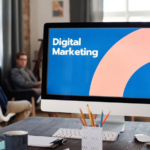
Metrics to Evaluate the ROI of Your Digital Marketing Campaigns
Are your digital marketing campaigns delivering the results you desire? As a savvy marketer, it’s crucial to assess the return on investment (ROI) of your efforts. With these business growth tips, you can easily boost your ROI. But with so many metrics and data points available, where do you begin?
Don’t fret! In this blog post, we’ll guide you through some key metrics that can help evaluate the success of your digital marketing campaigns. From conversion rates to customer acquisition costs, we’ll explore them all.
Conversion Rate
 This rate basically measures the authentic percentage of website visitors taking a desired action. These include making a purchase, filling out a form, or signing up for a newsletter. High conversion rates mean your marketing efforts are successfully driving user engagement and prompting them to take action. On the other hand, a low conversion rate may indicate that your messaging or targeting needs improvement. To improve your conversion rate, start by analyzing your website’s user experience.
This rate basically measures the authentic percentage of website visitors taking a desired action. These include making a purchase, filling out a form, or signing up for a newsletter. High conversion rates mean your marketing efforts are successfully driving user engagement and prompting them to take action. On the other hand, a low conversion rate may indicate that your messaging or targeting needs improvement. To improve your conversion rate, start by analyzing your website’s user experience.
You can also leverage persuasive copywriting techniques. Craft compelling headlines and descriptions that resonate with your target audience’s pain points and aspirations. Use testimonials or case studies to build trust and credibility.
Customer Acquisition Cost (CAC)
When it comes to evaluating the success of your digital marketing campaigns, one of the key metrics to consider is Customer Acquisition Cost (CAC). CAC refers to the amount of money you spend on acquiring a new customer. It takes into account all the costs related to attracting and converting leads into paying customers. Calculating CAC involves dividing your total marketing expenses by the number of new customers acquired during a specific period. This metric provides valuable insights into how efficiently you are using your resources to gain customers. With this, you can identify which channels or strategies are delivering the most cost-effective results. For example, if you find that your CAC is particularly high for certain advertising platforms or campaigns, it may be worth exploring alternative tactics that offer better ROI.
Return on Ad Spend (ROAS)
Next up, we’ve got ROAS. Return on Ad Spend (ROAS) provides insights into how much real revenue you generate for every dollar spent on advertising. To calculate ROAS, simply divide the revenue generated from your ads by the cost of those ads and multiply it by 100 to get a percentage. A higher ROAS indicates that your campaign is generating more revenue compared to its cost, while a lower ROAS suggests inefficiency. ROAS allows you to determine which advertising channels or strategies are delivering the best return on investment. By analyzing this metric, you can optimize your ad budget allocation and make informed decisions about where to invest more or less.
Traffic and Engagement Metrics
 These metrics provide valuable insights into how well your campaign is attracting and retaining users. But first, let’s talk about website traffic. Monitoring the number of visitors to your site gives you an idea of its popularity and reach. You can track this metric through tools like Google Analytics. Why? This tool provides detailed data on user behavior, such as page views, unique visitors, and session duration. However, it’s not just about the quantity but also the quality of traffic that matters.
These metrics provide valuable insights into how well your campaign is attracting and retaining users. But first, let’s talk about website traffic. Monitoring the number of visitors to your site gives you an idea of its popularity and reach. You can track this metric through tools like Google Analytics. Why? This tool provides detailed data on user behavior, such as page views, unique visitors, and session duration. However, it’s not just about the quantity but also the quality of traffic that matters.
Metrics like bounce rates and average time spent on the site help gauge how engaged visitors are with your content. Engagement metrics go beyond basic website visits by measuring user interactions with specific elements on your site. This includes actions like clicks on call-to-action buttons or social media shares. In addition to these quantitative metrics, qualitative factors such as sentiment analysis should also be considered when evaluating engagement levels.
The Bottom Line
When evaluating the ROI of your digital marketing campaigns, it’s important to look at all these metrics collectively rather than in isolation. Each metric provides valuable information about different aspects of campaign performance, but only when considered together do they paint a complete picture.…








 Instagram is one of the most popular social media platforms amongst younger generations, with over one billion active users worldwide. Its unique interface encourages visual storytelling through pictures and videos, making it a perfect platform for entrepreneurs to showcase their offerings in an attractive way. While some business owners may require more advanced features such as analytics or shoppable posts, Instagram can still be used to create brand awareness by providing behind-the-scenes looks into your business, collaborating with influencers, and leveraging hashtags.
Instagram is one of the most popular social media platforms amongst younger generations, with over one billion active users worldwide. Its unique interface encourages visual storytelling through pictures and videos, making it a perfect platform for entrepreneurs to showcase their offerings in an attractive way. While some business owners may require more advanced features such as analytics or shoppable posts, Instagram can still be used to create brand awareness by providing behind-the-scenes looks into your business, collaborating with influencers, and leveraging hashtags. Facebook has been the king of social media for years now, boasting over two billion active users. Its well-rounded features offer more control than other platforms, allowing you to craft a comprehensive marketing campaign tailored to your needs. While it may not be the most visually engaging platform, building a page and creating content can help you spread your brand’s awareness and create an engaged community with customers.
Facebook has been the king of social media for years now, boasting over two billion active users. Its well-rounded features offer more control than other platforms, allowing you to craft a comprehensive marketing campaign tailored to your needs. While it may not be the most visually engaging platform, building a page and creating content can help you spread your brand’s awareness and create an engaged community with customers. Twitter is fast-paced and constantly evolving, making it perfect for businesses that want to stay in touch with trends and relevant conversations. It’s a great platform to engage with customers on a more personal level and share snippets of news or announcements about your business. Twitter also allows you to monitor conversations about your brand and join in on relevant topics related to your industry. However, with a short character limit of 280 and no option for visuals or videos, it cannot be easy to convey complex ideas – so if you’re looking for an avenue to share long-form content, then Twitter may not be the best fit.
Twitter is fast-paced and constantly evolving, making it perfect for businesses that want to stay in touch with trends and relevant conversations. It’s a great platform to engage with customers on a more personal level and share snippets of news or announcements about your business. Twitter also allows you to monitor conversations about your brand and join in on relevant topics related to your industry. However, with a short character limit of 280 and no option for visuals or videos, it cannot be easy to convey complex ideas – so if you’re looking for an avenue to share long-form content, then Twitter may not be the best fit.
 Your website is the first image potential clients will have of your business, so it’s essential to ensure it’s up-to-date and reflects well on your brand. Ensure all your content is accurate and relevant and that your site is easy to navigate. If potential customers can’t find what they’re looking for, or if your site is challenging to use, they will probably move on to a competitor’s site. Investing in a professionally designed website is worth the cost, as it will pay off in the long run.
Your website is the first image potential clients will have of your business, so it’s essential to ensure it’s up-to-date and reflects well on your brand. Ensure all your content is accurate and relevant and that your site is easy to navigate. If potential customers can’t find what they’re looking for, or if your site is challenging to use, they will probably move on to a competitor’s site. Investing in a professionally designed website is worth the cost, as it will pay off in the long run. Social media is a powerful marketing tool that can help you reach many potential customers. You’re missing out on a valuable opportunity if you’re not using social media to market your business. There are many social media platforms to choose from, so selecting the ones most relevant to your business is essential. It’s also important to create exciting quality content. No one wants to read a sales pitch, so make sure your posts are informative and valuable.
Social media is a powerful marketing tool that can help you reach many potential customers. You’re missing out on a valuable opportunity if you’re not using social media to market your business. There are many social media platforms to choose from, so selecting the ones most relevant to your business is essential. It’s also important to create exciting quality content. No one wants to read a sales pitch, so make sure your posts are informative and valuable.


 One of the best ways to increase brand visibility is to give your brand a personality. This means creating a character or persona that represents your company. This persona should be relatable and likable, and it should be something that people can connect with. You can use this persona in your marketing materials, social media, and any other interactions with potential and current customers. If you don’t already have a brand persona, sit down and brainstorm who your ideal customer is.
One of the best ways to increase brand visibility is to give your brand a personality. This means creating a character or persona that represents your company. This persona should be relatable and likable, and it should be something that people can connect with. You can use this persona in your marketing materials, social media, and any other interactions with potential and current customers. If you don’t already have a brand persona, sit down and brainstorm who your ideal customer is. If you want to increase brand visibility, one of the best things you can do is create more video content. Video is viral right now, and it’s a great way to get your message across. You can post videos on social media, your website, or even on YouTube. Another great way to increase brand visibility is to create a blog. A blog is a great platform to share your thoughts, experiences, and knowledge. You can also use a blog to promote your business or product.
If you want to increase brand visibility, one of the best things you can do is create more video content. Video is viral right now, and it’s a great way to get your message across. You can post videos on social media, your website, or even on YouTube. Another great way to increase brand visibility is to create a blog. A blog is a great platform to share your thoughts, experiences, and knowledge. You can also use a blog to promote your business or product.
 One of the best ways to market your mobile business app is to create a viral loop referral campaign. This campaign encourages users to invite their friends and family members to download and use the app. To make this type of campaign successful, you will need to offer an incentive for users who refer others to the app. For example, you could offer a discount on products or services for each person who is referred. You will also need to make it easy for users to share the referral link with their contacts.
One of the best ways to market your mobile business app is to create a viral loop referral campaign. This campaign encourages users to invite their friends and family members to download and use the app. To make this type of campaign successful, you will need to offer an incentive for users who refer others to the app. For example, you could offer a discount on products or services for each person who is referred. You will also need to make it easy for users to share the referral link with their contacts. Once you have created a landing page for your app, it is time to start marketing it through the proper channels. There are many ways to do this, but some of the most effective include social media, email marketing, and paid advertising. When using these channels, be sure to target your audience to reach the people who are most likely to be interested in your app. You should also create compelling content that will grab attention and encourage people to click through to your landing page.
Once you have created a landing page for your app, it is time to start marketing it through the proper channels. There are many ways to do this, but some of the most effective include social media, email marketing, and paid advertising. When using these channels, be sure to target your audience to reach the people who are most likely to be interested in your app. You should also create compelling content that will grab attention and encourage people to click through to your landing page.
 Before contacting any marketing agencies, you need to have a clear vision for your business. What are your goals? What are you looking to achieve? What services or products do you offer? Once you understand your business, you can start outlining what specific needs and wants you have for your marketing campaign.
Before contacting any marketing agencies, you need to have a clear vision for your business. What are your goals? What are you looking to achieve? What services or products do you offer? Once you understand your business, you can start outlining what specific needs and wants you have for your marketing campaign. Marketing agencies can track various data, such as website traffic, social media followers, leads, and conversions. It is important to understand what kind of tracking and reporting you need from the agency in order to make sure they are meeting your expectations. This is one of the easiest ways to tell if an agency is doing a good job or not.
Marketing agencies can track various data, such as website traffic, social media followers, leads, and conversions. It is important to understand what kind of tracking and reporting you need from the agency in order to make sure they are meeting your expectations. This is one of the easiest ways to tell if an agency is doing a good job or not.